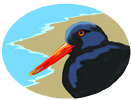
Western Gulls are the only gulls that nest here on the coast. One of the reasons birders don't call gulls seagulls is that most of them nest inland far away from the sea. You can impress your friends in springtime by identifying the large gull with white head and pink feet as a Western Gull since they are the only ones here in any numbers.
Western Gulls are two feet tall. It takes four years to achieve the adult plumage. As adults they have a white head, dark gray back and wings. They have a thick, long, yellow bill and pink legs, and black wing tips showing a few white spots. In flight, the underside of the wings looks dark grayish with black at the tips.
Young gulls are dark brown all over and have a black beak. You can identify the first, second and third year gulls by the gradations of white on their heads and the reduction of black in the beak. Adults are known to live for over sixteen years.
Western Gulls used to be oceanic and intertidal feeders, but they have adapted to humans and are expert scavengers. They are said to feed on anything remotely edible. You can see them at waterfronts, parks and garbage dumps snatching scraps and waiting for handouts. They also steal other eggs and chicks from seabird colonies.
Western Gulls often nest on offshore islands and protected mainland cliffs. They will nest singly or colonially. The nest is a shallow scrape on the ground lined with plants. They typically lay three buff-colored, mottled eggs that are incubated for a month by both adults. The red spot on the parent's bill serves as a mark for the young to peck, stimulation the adult regurgitate its meal. The young stay with their parents for seven weeks.
Western Gull photo by Ron LeValley www.LeValleyphoto.com
